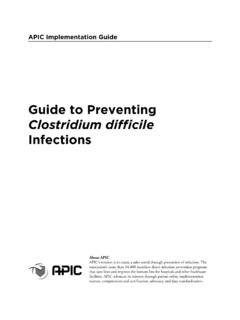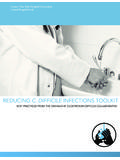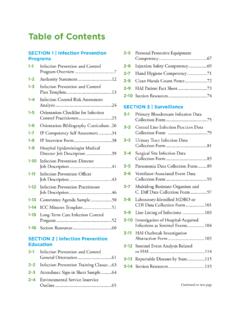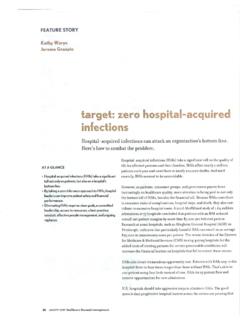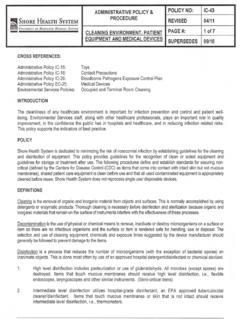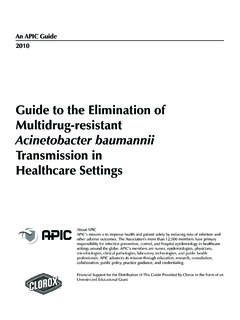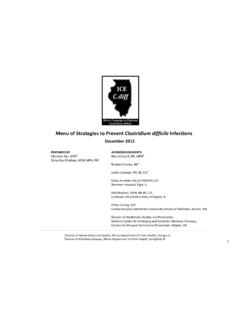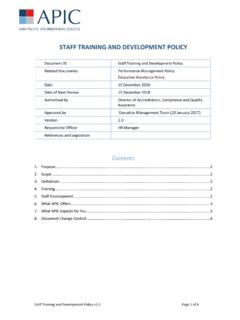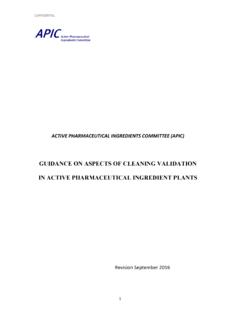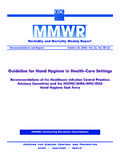Transcription of ImpGuide CLABSI Cover wSpine17x11 rev3.indd 1 …
1 Guide to preventing central line - associated Bloodstream Infections About apic . apic 's mission is to create a safer world through prevention of infection. The association's more than 15,000 members direct infection prevention programs that save lives and improve the bottom line for hospitals and other healthcare facilities. apic advances its mission through patient safety, implementation science, competencies and certification, advocacy, and data standardization. About the Sponsor As a long-standing apic Strategic Partner, BD is pleased to support the dissemination as a free resource of the revised apic . Implementation Guide on CLABSI . About the Implementation Guide Series apic Implementation Guides help infection preventionists apply current scientific knowledge and best practices to achieve targeted outcomes and enhance patient safety. This series reflects apic 's commitment to implementation science and focus on the utilization of infection prevention research.
2 Topic-specific information is presented in an easy-to-understand and use format that includes numerous examples and tools. Visit to learn more and to access all of the titles in the Implementation Guide series. Printed in the United States of America First edition, December 2015. ISBN: 1-933013-56-7. All inquiries about this guide or other apic products and services may be directed addressed to: apic . 1275 K Street NW, Suite 1000. Washington, DC 20005. Phone: 202-789-1890. Fax: 202-789-1899. Email: Web: 2015, Association for Professionals in Infection Control and Epidemiology, Inc. ( apic ). Disclaimer All rights reserved. Use of this apic Guide does not grant any right of ownership or license to any user. The Association for Professionals in Infection Control and Epidemiology, its affiliates, directors, officers, and/or agents (collectively, apic ) provides this Guide solely for the purpose of providing information to apic members and the general public.
3 The material presented in this Guide has been prepared in good faith with the goal of providing accurate and authoritative information regarding the subject matter covered. However, apic makes no representation or warranty of any kind regarding any information, apparatus, product, or process discussed in this Guide and any linked or referenced materials contained therein, and apic assumes no liability therefore. WITHOUT LIMITING THE GENERALITY OF THE FOREGOING, THE INFORMATION AND MATERIALS PROVIDED. IN THIS GUIDE ARE PROVIDED ON AN AS-IS BASIS AND MAY INCLUDE ERRORS, OMISSIONS, OR OTHER. INACCURACIES. THE USER ASSUMES THE SOLE RISK OF MAKING USE AND/OR RELYING ON THE INFORMATION. AND MATERIALS PROVIDED IN THIS GUIDE. apic MAKES NO REPRESENTATIONS OR WARRANTIES ABOUT. THE SUITABILITY, COMPLETENESS, TIMELINESS, RELIABILITY, LEGALITY, UTILITY OR ACCURACY OF THE.
4 INFORMATION AND MATERIALS PROVIDED IN THIS GUIDE OR ANY PRODUCTS, SERVICES, AND TECHNIQUES. DESCRIBED IN THIS GUIDE. ALL SUCH INFORMATION AND MATERIALS ARE PROVIDED WITHOUT WARRANTY. OF ANY KIND, INCLUDING, WITHOUT LIMITATION, ALL IMPLIED WARRANTIES AND CONDITIONS OF. MERCHANTABILITY, FITNESS FOR A PARTICULAR PURPOSE, TITLE, AND NON-INFRINGEMENT. IN NO EVENT SHALL apic BE LIABLE FOR ANY INDIRECT, PUNITIVE, INCIDENTAL, SPECIAL, OR. CONSEQUENTIAL DAMAGES ARISING OUT OF OR IN ANY WAY CONNECTED WITH THE USE OF THIS GUIDE. OR FOR THE USE OF ANY PRODUCTS, SERVICES, OR TECHNIQUES DESCRIBED IN THIS GUIDE, WHETHER. BASED IN CONTRACT, TORT, STRICT LIABILITY, OR OTHERWISE. Table of Contents Chapter 1: Success in CLABSI Reduction through Major Initiatives .. 6. Chapter 2: Epidemiology and Pathogenesis .. 16. Chapter 3: Surveillance .. 20. Chapter 4: Beyond the ICU: Expanding Target Populations.
5 29. Chapter 5: Ensuring Adherence to the central line Bundle Prevention during Insertion .. 32. Chapter 6: preventing Infections during Catheter Maintenance.. 39. Chapter 7: Review of Current and Additional Prevention Strategies.. 47. Chapter 8: preventing CLABSI in the Pediatric Population.. 55. Chapter 9: CLABSI Prevention in the Setting of Renal Disease .. 62. Chapter 10: preventing Infection during Long-Term Device Use .. 67. Appendix: Major Interdisciplinary Resources for CLABSI Prevention .. 71. Acknowledgments Accomplishing this comprehensive update required input and expertise from a broad array of experts from practice and research settings. The Association for Professionals in infection Control and Epidemiology acknowledges the valuable contributions from the following individuals. Editor Contributors Linda Goss, MSN, APRN, NP-C, CIC, COHN-S Vicky Allen, MSN, RN, CIC.
6 University of Louisville Global Health Center CaroMont Health Louisville, KY Gastonia, NC. Authors Lisa A. Gorski, MS, HHCNS-BC, CRNI, FAAN. Sue Barnes, RN, BSN, CIC Wheaton Franciscan Home Health & Hospice Kaiser Permanente Healthcare System National Office Milwaukee, WI. Oakland, CA Adriene Y. Thornton, RN, MA, CIC. Russell N. Olmsted, MPH, CIC Children's Hospitals and Clinics of Minnesota Trinity Health Minneapolis, MN. Livonia, MI Alice B. Atcher, BSN, RN, CCRN, CRNI. Elizabeth Monsees, RN, MSN, MBA, CIC University of Louisville Hospital Children's Mercy Hospital and Clinics Louisville, Kentucky Kansas City, MO Leigh Ann Bowe-Geddes, RN, CRNI, VA-BC. Jo Ellen Harris, RN, CIC University of Louisville Hospital All Children's Hospital, Johns Hopkins Medicine Louisville, KY. Saint Petersburg, FL Jacqueline Galluzzo, MS, RN, CIC. Raed Khoury, MA, MPH, MT (ASCP), CIC The Johns Hopkins Hospital Kaiser Permanente Hospital Baltimore, MD.
7 Fresno, CA. Lynn Hadaway, MEd, RN, BC, CRNI. Lynn Hadaway Associates, Inc. Milner, GA. Gemma Downham, MPH, CIC. AtlantiCare Regional Medical Center Pomona, NJ. Reviewers Production Team Diane Jacobsen, MPH, CPHQ Caroline H. Fuchs, CAE. Institute for Healthcare Improvement Vice President, Marketing and Practice Resources Cambridge, MA Association for Professionals in Infection Control and Epidemiology Madeleine Ashcroft, RN, MHS, CIC Christina James, MPA. Public Health Ontario Editorial Assistant, Practice Resources Brampton, ON Canada Association for Professionals in Infection Control and Epidemiology Cathy Perry, DNP, APRN, ANP-BC, VA-BC, CRNI Sarah Vickers Vanderbilt University Medical Center Art Director Nashville, TN Association for Professionals in Infection Control and Epidemiology Susan F. Sandler Associate Director, Practice Resources Association for Professionals in Infection Control and Epidemiology Daria Steigman President Steigman Communications Project Design Company Washington, DC.
8 Declarations of Conflicts of Interest Only individuals who have made declarations of potential conflicts have been listed here. Lynn Hadaway is the 2015 chair of the Infusion Nurses Certification Corporation and chair of the Infusion Nurses Society, Infusion Team Task Force. She is owner of Lynn Hadaway Associates, Inc., a for-profit consulting and education company. Consulting services were provided to the following manufacturing clients: 3M; B. Braun Medical; Baxter Healthcare; BD Medical; Covidien; DEKA Research and Development ; Excelsior Medical; Ivera Medical, recently acquired by 3M; Infrared Imaging Systems;. Terumo Medical; Vascular Access Teaching Aids (VATA); Velano Vascular; Bard Access Systems; and Excelsior Medical. Lisa A. Gorski has been a presenter sponsored by DB, 3M, and Covidien. Linda Goss is a 2015 member of the Certification Board of Infection Control (CBIC) and a consultant for Meiko, Inc.
9 Adriene Y. Thornton is a director-at-large (appointed November 2014) for the Minnesota Chapter of apic and on the Board of Directors since 2010 for The Arc Greater Twin Cities. The Arc promotes and protects the human rights of people with intellectual and developmental disabilities. Guide to preventing central line - associated Bloodstream Infections | 5 Introduction Prevention of device- associated infection represents a complex challenge for the infection prevention team as well as the many stakeholders involved in those prevention activities. Furthermore, as the characteristics of the host patient become increasingly compromised, it is vital that there be an attention to basic practice coupled with knowledge of process improvement opportunities. This implementation guide is designed to provide basic information regarding the prevention of central line - associated bloodstream infection that is applicable for use by all infection preventionists (IPs), regardless of their practice setting or their level of experience.
10 The information provided will facilitate the learning of basic concepts and provide both the novice and the experienced IP with an opportunity to objectively evaluate current practice within the framework of continuous improvement. The goal of this implementation guide is to outline practices that are core to prevention efforts, demonstrate application through associated tools and resources, and provide information that augments existing evidence-based guidelines including the Healthcare Infection Control Practices Advisory Committee (HICPAC) 2011 Guidelines for the Prevention of Intravascular Catheter-Related Infection. A strength of this implementation guide is demonstrated by the collaborative efforts of the many contributors and reviewers who have worked together to compose a document that has been peer-reviewed and is immediately useful in practice. The true measure will be a reduction in infection experienced by patients.
